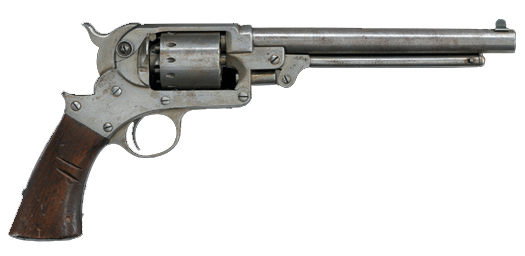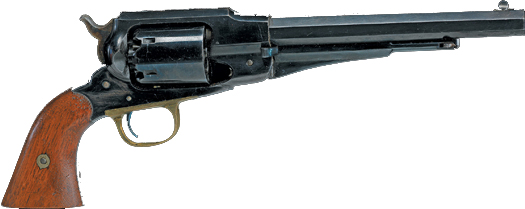 DDM
DDMON OCTOBER 3, 1864, LIEUTENANT JOHN R. MEIGS, Major General Philip Sheridan’s topographical engineer and the son of Quartermaster General Montgomery Meigs, was riding in the rain with two Union soldiers near Dayton, Virginia, when they overtook three horsemen whose capes covered their uniforms. Meigs called on the men to halt. They were Confederate scouts who drew pistols and fired, killing Meigs. The Confederates captured one of the Union soldiers; the other escaped to tell of the shooting, which Sheridan considered partisan warfare. In retaliation, he had houses in and around Dayton torched.
As this incident demonstrated, handguns could be potent weapons when opponents met at close quarters during the Civil War. Some infantrymen and most officers carried them, and they were often issued to seamen and cavalrymen, who were more likely than foot soldiers to come near enough to their enemies to make handguns useful. Although they remained strictly short-range weapons, those side arms had evolved dramatically in recent years from the cumbersome single-shot muzzle-loaders of old. That era ended in 1848 when Samuel Colt sold a thousand of his innovative .44-caliber revolvers to the U.S. Army, which issued them to dragoons (mounted infantrymen). A few years later, Colt came out with a lighter, .36-caliber revolver. Because the U.S. Navy was an early customer and the cylinder bore an engraved naval battle scene, that model became known as the Colt 1851 Navy Revolver. Thereafter, .44-caliber revolvers were termed “Army” and .36-caliber revolvers were termed “Navy.” Both Colt models were percussion revolvers, which required a percussion cap to be placed at the rear of each bore in the cylinder before the trigger was pulled, bringing the hammer down on the cap and igniting a cartridge filled with gunpowder and a bullet. As was the case with long arms, few revolvers in use during the Civil War fired self-contained metal cartridges that eliminated the need for percussion caps.
Most of the handguns made by Colt and other American gun makers at that time were single-action revolvers, meaning that pulling the trigger performed only one action—firing the gun. Before the trigger was pulled, the hammer had to be cocked manually, which also rotated the cylinder. Some revolvers in production then were double action, meaning that pulling the trigger cocked the hammer and rotated the cylinder as well as firing the gun. Most soldiers were accustomed to the single action, and few purchased or were issued double-action revolvers.
Colt, Remington, and Whitney were the major suppliers of Union handguns, but the government also purchased some from smaller companies and imported others from Europe. The Confederacy imported more revolvers than it produced at home. Unlike Colt, which made hundreds of thousands of revolvers during the war, few Southern contractors turned out as many as a thousand revolvers.  DDM
DDM

GUNMAN Soldiers like this Union sergeant often posed for studio portraits with handguns. Some were their own weapons, but most were provided as props by photographers.
COLT MODEL 1851 NAVY REVOLVER This .36-caliber six-shooter was Colt’s most popular percussion revolver. Nearly 250,000 were made between 1850 and 1873, and many soldiers and lawmen, as well as outlaws, carried them.

KERR REVOLVER The five-shot, .44-caliber Kerr was produced in England by the London Armoury Company and exported almost entirely to the Confederacy. A favorite of Southern cavalrymen, it could be fired in either single or double action.

STARR ARMY REVOLVER The .44-caliber Starr was the only American revolver produced in both single and double action during the war. This 1863 single-action model was considered an improvement over the double-action model.
COLT MODEL 1860 ARMY REVOLVER This .44-caliber six-shooter was one of the most widely used revolvers during the Civil War. Many Confederates carried this or other Colt models—or copies of them made by Southern contractors.

LEMAT REVOLVER French physician Jean Alexandre LeMat, an in-law of Confederate General P.G.T. Beauregard, developed the nine-shot .40-caliber LeMat, with a 16-gauge shotgun barrel. Nearly 3,000 were shipped to the South.

LEFAUCHEUX REVOLVER The French-made .44-caliber Lefaucheux had metallic cartridges that fired when punctured by pins driven by the hammer. Purchased by the Union, it was also carried by a few Confederate officers.
SAVAGE NAVY REVOLVER The .36-caliber six-shot Savage has a lower ring lever to cock the hammer and rotate the cylinder, and a trigger above that to fire the gun. Although hard to aim, some 12,000 were purchased by the Union.

GRISWOLD & GUNNISON REVOLVER A Connecticut Yankee who moved to Georgia, Samuel Griswold teamed with Arvin Gunnison in 1862 to produce this close copy of the Colt 1851 Navy Revolver. It was the best revolver made in the South.

REMINGTON 1861 ARMY REVOLVER Also known as the Old Model Army, this Remington held six shots in a solid frame. Along with its successor, the New Model Army, it helped make Remington second only to Colt in Union revolver sales.